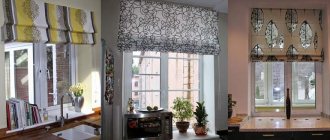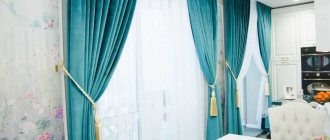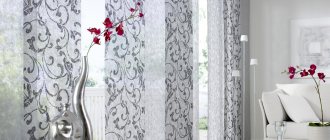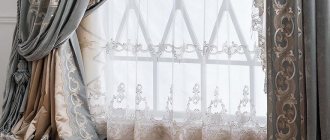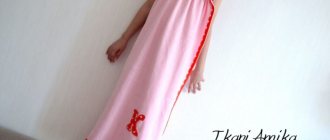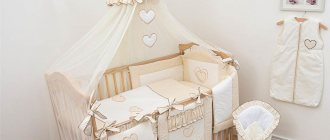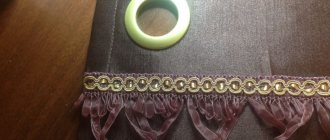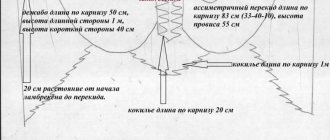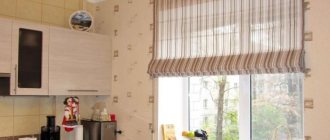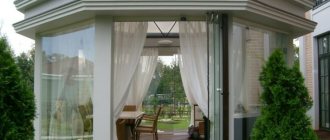Japanese panel curtains are modesty combined with laconicism, increased functionality and yet unconventional exoticism. As the name implies, the birthplace of such curtains is Japan. Residents of the Land of the Rising Sun highly value discreet asceticism, which is why the fabric panels decorating windows and doorways in their homes look simple, but perform several tasks at once:
- protect from sunlight;
- decorate the walls;
- zone the premises;
- visually expand the space;
- help create design styles such as minimalism, avant-garde or Japanese.
To fit such an element into the interior, several conditions must be met. First, choose a material that harmoniously combines with other decorative items. Secondly, consider options for placing curtain panels. And thirdly, disassemble the room and rid it of unnecessary furniture.
Installation of curtain panels
Panel curtains are designed quite simply. The main part of them is occupied by fabrics. With their upper part they are attached to simple or multi-layer Japanese cornices.
Cornices are made of plastic or light metal alloys. They can be bent in an arc, but this reduces the power of the electric motor (if the cornice is powered by an electric motor). The canvas is fixed to the cornice using Velcro. Special weighting agents are hidden in the lower part.
Cornice device
If panel curtains are used for zoning, then they are inserted from below into the horizontal bottom guide (this method is not always used).
In appearance, panel curtains resemble roller blinds, but in terms of functionality they are radically different. For example, special curtain rods allow you to move the curtain panel in any direction. They can have from 1 to 5 tracks.
And if the simplest cornices with 1 to 3 tracks are usually used to decorate windows, then more complex designs are used for zoning. They allow you to create very unusual multi-layered visual effects.
Options for “multi-layer” cornices
Advantages of Japanese curtain partitions
Almost always at least one of the rooms in a house or apartment serves us not only for its intended purpose. The bedroom is combined with a study, the kitchen with a dining room, the hallway with a dressing room, and the living room with a children's room. To use all functional areas at the same time, they must be separated by partitions. Japanese panels are ideal for this purpose.
Japanese partition curtains look especially advantageous in a studio apartment, the concept of which does not include building blank walls.
Let's consider their main advantages:
To the advantages of Japanese panels used as partitions, one can add an unusual combination of form and content in their design. Thanks to rigid inserts, each canvas looks flawlessly smooth. When placed close to each other or with a slight overlap, they create the illusion of a full-fledged permanent wall. But this wall is made of textiles. This material is designed to bring comfort and softness into our lives. Therefore, depending on the density and color of the fabric, such partitions can give the room both strict formality and home comfort.
Design features
Design features are something that must be taken into account when installing panel curtains. So, one or two panels in such curtains can be fixedly fixed. They are located closest to the window (in the center or on both sides) and are made of lightweight transparent material. Their task is to disperse sunlight during daylight hours.
If panel curtains are used to zone a room, then static elements are most often located outside as far as possible from the wall.
The standard length of Japanese curtain panels is from floor to ceiling (maximum value is 3.5 m), the width can vary from 0.5 to 1.6 m. But shortened models are also available, they are most often used to decorate windows on the balcony.
Operating principle
Japanese panel curtains are driven in different ways:
- manually . Not the most advantageous option, since the material from which the fabrics are sewn quickly gets dirty with constant contact with your hands. In addition, you need to have sufficiently high physical endurance to constantly move and push apart the panels;
- using cord cords or PVC chains . Such a cornice consists of a tire, a control mechanism and profiles: their number corresponds to the number of tracks. The profiles are attached to carriages that slide in track grooves. The position and length of the cord (chain) is determined individually in accordance with the wishes of the owners of the living space. The canvases in such cornices move in groups of 2-3 pieces. To change their position, you need to pull one edge of the cord (chain).
Installation of cornices on cords (chains)
- using an electric drive . The main thing in such a cornice is the engine and the supporting rail, inside of which the control mechanism is located. The engine is equipped with a small power unit that runs on electricity. The main mechanism is driven by the remote control. After pressing the button, a movable unit attached to a cable and running inside the tire begins to change the location of the blades.
The operating principle of an electric curtain rod for Japanese curtains:
In addition, curtain panels can also be fixed. In this case, they will perform a purely decorative function.
Conclusion
Do not forget that Japanese panels are also an excellent means for segmenting space. This is especially appropriate in the kitchen, because with the help of screen curtains you can divide one large kitchen into a dining room and a cooking area.
Related article: How much do window blinds cost?
The ease of installation of the systems allows you to carry out all the work yourself. Curtains installed in the kitchen have to be cleaned and washed more often than curtains in other rooms, so it is better not to use special floor curtain rods. Although they provide the most reliable fixation of the panels, they significantly complicate the process of caring for fabric sheets.
Where can I use it?
Japanese panel curtains look good in both small and large rooms. And the more modest the area available, the calmer the colors of such products should be.
But if:
- The room is not only cramped, but also has very small windows;
- the interior is decorated in cozy home styles (Provence, country) or elaborate “expensive” (empire, baroque);
- the room is literally littered with furniture, it is difficult to “breathe” in it, then in these cases it is better to refuse Japanese panel curtains. They simply won't fit into the interior.
Such fabric panels are appropriate everywhere: in the kitchen, living room, loggia and bedroom. For example, in the living room they can be used both as curtains, draping windows with them, and as doors, decorating the doorway with similar products.
In both cases, the color of the curtain panels is matched to the main shade of the interior, which allows you to visually expand the boundaries of the room.
european_furniture
contrejour_official
topfair
In the kitchen, panel curtains are indispensable, especially if the windows face the sunny side. High-tech, loft or minimalism - all these styles will sparkle in a new way if they are complemented by these functional products.
energy_djakovo
paneelgiant
Panel curtains are also necessary in the bedroom, because they so organically refract the color of the sun. As a result, the room is immersed in a pleasant twilight, which is diluted with minor splashes of color.
kvp.textiledesign
sunforce.ru
halogendecor
paneelgiant
A large, originally designed bathroom is another place that will only benefit from its “neighborhood” with such products. After all, panel curtains do not take up free space and create a comfortable level of privacy.
mottura_spa
Japanese curtains for dividing a room: a variety of options in the interior
Since ancient times, wall panels have been used by the Japanese to zone space in their homes. Nowadays Japanese curtains for
Room divisions are used everywhere in Russia and Europe. There are many explanations for this. With the help of sliding screens, you can separate and hide the dressing room from prying eyes, create a screen in the pantry or in the bathroom, and divide the children's room into boy's and girl's areas. You can organize space in a new way even in offices or swimming pools. With the help of Japanese curtains you can recreate a minimalist, classic or oriental style. Designers also suggest using them to decorate homes in ethno or high-tech style. Their design and materials allow a similar variety of stylistic solutions. And zoning with Japanese curtains on which photo printing will give your room an indescribable flavor.
Master class on making Japanese curtain panels
Even novice craftswomen (craftsmen) can sew Japanese panel curtains. After all, they are a symbiosis of several rectangular-shaped canvases. In the upper part there is Velcro, in the lower part there is a weighting agent. And all you need to do:
- cut the fabric to specific sizes;
- hem allowances;
- attach Velcro (soft part);
- iron the fabric;
- insert weights into it;
- glue the hard part of the Velcro to the profiles;
- hang ready-made curtains.
Let's look at each stage step by step.
Sewing curtains with eyelets
Master Class. We compare the cost of finished products and hand-sewn ones
Instructions
More details
How to sew Roman blinds
Step-by-step instructions for beginners and intermediates
Instructions
More details
How to make thread curtains yourself
Step-by-step master class. How much does it cost to make a curtain with your own hands?
Instructions
More details
DIY roller blinds
Step-by-step instructions for making roller blinds
Instructions
More details
List of required materials
Japanese panel curtains must be mounted on a special cornice. But since its cost is not affordable for everyone, you can use a regular ceiling holder. The maximum number of tracks in such a product is 3. And if there are more panels, then you need to install two ceiling cornices together.
In addition to the cornice, to make such curtains you will need to purchase:
Textile
Threads
Weighting material, such as lead thread
Velcro (or curtain tape and hooks)
After this, you need to decide on the density, color and number of textile fabrics and get to work.
List of required tools
To sew a panel curtain, you need to prepare in advance:
A bar of dry soap or chalk
Long ruler
Large tailor's scissors
Thread and needle
You will also need an iron: you can use it to quickly iron seam allowances.
Calculations
To calculate how much material you need to purchase to sew panel curtains for a specific window, you need to do the following:
- measure the width and height of the window;
- decide how long the future curtain should be;
- determine how wide one panel should be;
- decide how many panels in total will be placed on the cornice.
For example:
- Window width - 3 m, height - 2.50 m.
- The width of one panel is 70 cm, the height is 2.50 m.
- The window will have four panels made of thick fabric and one of thin fabric.
- Fabric consumption: dense material - cut size 320 x 270 cm, thin material - cut size 80 x 270 cm.
- Dimensions are given taking into account allowances (4 cm on both sides, 5 cm on top and 5 cm on the bottom). The allowances can be reduced slightly.
Fabric preparation and processing
If the curtain is made from natural or artificial fabrics that shrink significantly, then before cutting the material it will need to be washed or thoroughly wetted and allowed to dry. Then the fabric will need to be ironed and only after that proceed to further work.
If the material practically does not shrink, it will be enough to iron it from the wrong side.
Short Japanese panel curtains, consisting of two types of materials:
How to sew curtains
Preliminary work:
- The material is spread on the floor or a long wide table.
- The location of the lobe and transverse threads is determined (cutting is done along the lobe thread, otherwise the finished fabric may skew). This is done like this: a piece of fabric is stretched in all directions. And the direction that lends itself to stretching the worst is the location of the lobar threads.
- Using a long ruler and a piece of chalk (soap), markings are made. At this stage, side, top and bottom allowances must be taken into account.
- The fabric is cut into rectangular sheets of the required width (in our example - 70 cm + 8 cm for side allowances).
Main part (steps are repeated sequentially on all canvases):
- The side sections are turned inside out and secured with an iron.
- Allowances are secured by machine stitching or by hand.
- The upper and lower allowances are laid, also secured with an iron and stitched.
- If the curtain panel will hang on the ceiling cornice, a curtain tape is sewn to its top (on the reverse side). If it is attached to a special cornice, then the Velcro is divided into two parts, and the soft one is attached to the top of the product. You can hang a Japanese panel curtain on a pipe-shaped cornice. In this case, the main part of the pipe-shaped crossbar is simply inserted into the upper “pocket” (it was obtained as a result of stitching the seam allowance).
- A weighting agent is inserted into the lower allowance.
- The edges of the allowance are slightly sewn together so that it does not pop out when the curtains move.
That's it, the curtains are ready. All that remains is to hang them on the cornice.
Installation on a cornice
You need to understand that if not a special, but an alternative cornice (in the shape of a pipe) is used to install Japanese panel curtains, then such products will either perform a decorative function or will simply replace ordinary curtains. In this case, you won’t be able to create an unusual overlay effect. When using several ceiling holders that are mounted next to each other, it should be remembered that the space between the canvases will not have the same dimensions. This will also negatively affect the overall visual picture.
To secure the curtain to a special curtain rod, you must:
- glue the hard part of the Velcro to the outside of each profile using a glue gun;
- take the finished canvas and carefully connect the Velcro together;
- the finished part of the curtain is moved to the side, and the next canvas is attached to the next profile.
In this case, each canvas should overlap the adjacent canvas by approximately 5 cm.
Long curtains on the ceiling cornice:
